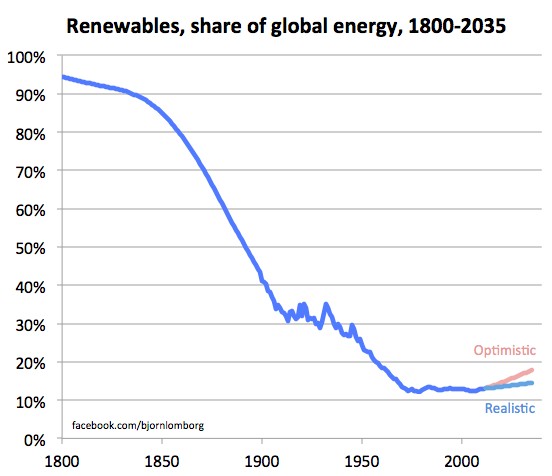Is Renewable Energy Stuck?
 Expectations on the growth and deployment of renewable energy vastly exceed actual growth of green energy, says Dr. Bjorn Lomborg, Director of the Copenhagen Consensus Center.
Expectations on the growth and deployment of renewable energy vastly exceed actual growth of green energy, says Dr. Bjorn Lomborg, Director of the Copenhagen Consensus Center.As reported in a News Brief from the Center, a new survey shows that the average American believes use of renewable energy sources will jump from 13% of our energy today to 30.2% by 2035.
In fact, says the News Brief, renewable energy is in decline. A leap away from fossil fuels necessitates huge investments in green research and development. Luckily, these investments will be much cheaper than the current subsidies for inefficient and expensive green technology.
While 94 percent of the world’s energy came from renewables in 1800, this number had fallen to 13.12 percent by 1971.

Despite ample subsidies for solar and wind generation in recent years, the share of all renewable energies continued its decline, reaching 12.99 percent in 2011. Even in their most optimistic scenario, the International Energy Agency predicts green energy to increase by only 1.5 percentage points through 2035.
“This shows that the hundreds of billions of dollars rich countries invest in green subsidies fail to convert our energy production towards a more sustainable system”, says Dr. Lomborg
“While fossil fuels have created massive prosperity throughout the world, we still need to mitigate their harmful effects. It would be great if the world could use more green energy. But wishful thinking and unaffordable subsidies will not get us there – the answer is research and innovation”, Lomborg concludes.
In his new Slate commentary “Green Energy Needs to be Cheaper”, Lomborg analyzes the decline of renewable energy over time and presents future perspectives.
In that commentary Lomborg notes “Solar and wind energy account for a trivial proportion of current renewables-about one-third of one percent. The vast majority comes from biomass, or wood and plant material-humanity’s oldest energy source. While biomass is renewable, it is often neither good nor sustainable.”
You can return to the main Market News page, or press the Back button on your browser.

